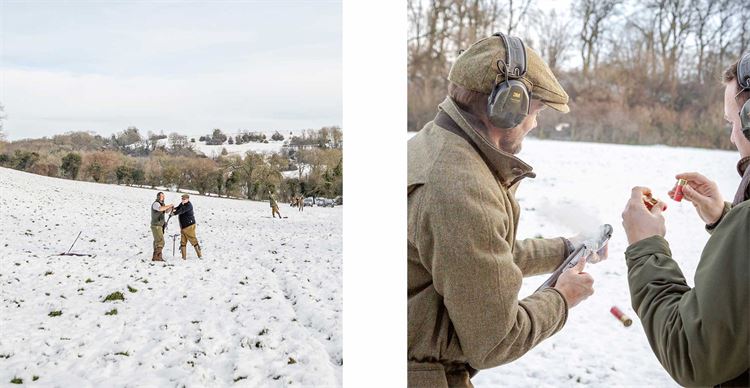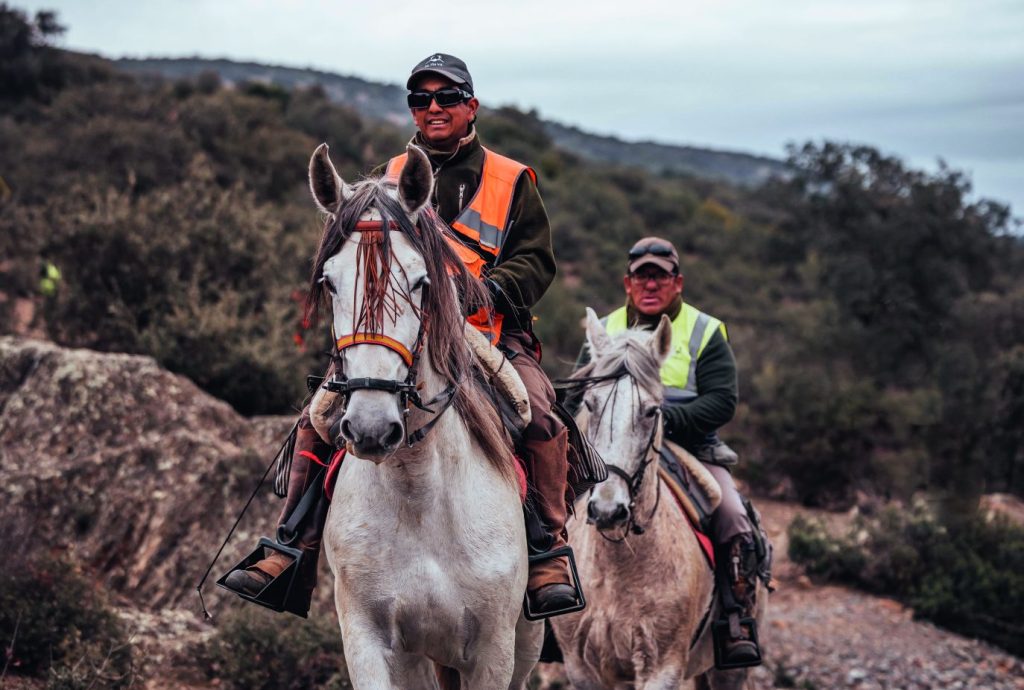Badminton Shoot
Shooting in a winter wonderland at Badminton House.

What comes to your mind when asked to imagine a quintessentially British winter scene? A robin perched on a snow-topped postbox? Children sledging on a hillside? A city street awash with red, blue, green and gold lights? Or, as a reader of this magazine, do you imagine a team of Guns crunching their way across a snowy valley floor with slipped guns over shoulders, some carrying a brace of pheasants in one hand, a few dogs walking to heel, warm breath glowing in the winter sun’s hues? I know I do.
Days like this are hard to come by, though. In the past 40 years the UK has seen on average 23.7 days of snowfall per year, with snow settled on the ground for just 15.6 of them – the majority in the north of England, Scotland and mountainous regions. In the south, the milder winters of late have seen an average of less than three days of snow, mostly falling in late January and February, and as a result the chances of a lowland shoot day akin to that featured on a Christmas card are scarce.
Last winter things were different, however, and a south of England shoot day in the snow was almost guaranteed as flurries of the white stuff started as early as the first week of December and stuck around until way beyond the end of the season. The first snow day for me was on December 12, and where better to be than at the Badminton Estate shoot in the heart of the Cotswolds – a designated Area of Outstanding Natural Beauty due to its traditional and significant British landscape values.
Badminton House has been the principal seat of the Duke of Beaufort since the late 17th century. In that time the house and surrounding parkland have undergone some significant growth and remodelling by famous architect William Kent and landscape genius Lancelot ‘Capability’ Brown, among others, making it one of the most prestigious, primarily private Palladian-style houses in existence today. Looking beyond the fact that the globally popular racket sport of badminton is named after the house (due to army officers developing the sport from ancient games in the entrance hall in 1873), Badminton has played host to country sports for centuries.
Indeed, the estate boasts one of the oldest and largest pack of foxhounds, the Duke of Beaufort’s Hunt, which was formed in 1640 and still has a loyal following today. In 1949, the 10th Duke hosted the first ever Badminton Horse Trials to allow British riders to train for future international events – the second three-day event of its kind in Britain following the 1948 London Olympics – and, of course, the estate has hosted game shooting for many years.
Dawn had broken by the time I passed through the gated archway of the courtyard of the impressive main house. A few members of the team along with headkeeper Paul Barret had already arrived and were happily taking shelter from the cold by the fire in the Stewards Room in the West Wing – the rendezvous point for all of the estate’s shoot days.
Shooting was the 11th Duke of Beaufort’s passion, and he did all he could to lay the foundations that have allowed Badminton to evolve into the shoot that it is today. “When I first started working on the estate as underkeeper in 1980, straight after leaving school, the shoot was small and most of the drives were on the flat ground around the house,” said Paul. Today, the shoot operates on the north and south side of the estate over a vast expanse of land – think traditional Cotswold valleys and hillsides with ample woodland to boot. “It’s been a mammoth undertaking, but we are very proud of how far we have come.”
Sadly, the 11th Duke of Beaufort passed away in 2017 and the shoot was passed on to his son, Henry Somerset, now the 12th Duke of Beaufort. Gladly, he shares his father’s passion for the sport, and the goal remains to maintain the reputation for being a top quality and responsible shoot with a friendly, family-orientated atmosphere. As testament to the success of that, one need only look so far as the staff, many of whom have worked on the estate for a long time. “I’ve lived on the estate all of my life – my father was the headkeeper for 20 years before me – and my three underkeepers have been here since they left school, too. The Beauforts have been a great family to work for,” Paul added. “Every shooting party, however big or small, is welcomed into the home as if they are guests of the family. You don’t get that on many other shoots.”
By 9am the full team of nine Guns was present, and so to the briefing. The plan was to shoot four drives, split by an elevenses stop, before finishing back in the West Wing with a two-course lunch in the Old Hall – referred to as the ‘Antler Room’ by regulars due to its walls being adorned with European skull mounts of red deer from the estate along with a few other species from further afield. Though it is not set in stone, this is the typical format of a day at Badminton.
We loaded into trucks, two or three men in each, and set off to the south side of the estate for the first drive, Nicky’s. Before each day gets underway, Paul will confirm or adjust plans with his underkeepers and the beating team, the latter never more than 20 strong. It’s a real team effort. “Many surrounding shoots have had to cancel their days this week due to the snow severely affecting access,” said Paul. “We have 18 drives in total, but the south side is much lower, so when bad weather comes – be it snow or thick fog – it shouldn’t prevent us from putting on a full day’s shooting. In that regard we are very lucky.”
We parked up beside a dry stone wall and moments later followed Paul’s lead to the pegs that were adjacent to a small brook. After time to get settled and ready, the pheasants were pushed over the line in a steady stream of ones and twos.
“Cotswold shooting is all about good-quality high birds in picturesque countryside, and at Badminton the aim is to produce pheasants and partridges which are both challenging and memorable on every drive,” said Mathew Latchford from Roxtons and Ian Coley Sporting, who work closely with the estate. “On top of this, there is great emphasis placed on hospitality and atmosphere, both of which are areas you can guarantee to be exceptional come rain or shine.”
Whilst the second drive was underway, a table was beautifully laid out by a dedicated member of staff with all you could want from an elevenses stop. “This year we have really pushed serving game at elevenses,” said Mathew. “We offer venison sausages over traditional pork, along with partridge goujons – both of which have been very popular. It’s a great way of using game and it’s the responsible thing to do.”
Another example of the estate doing the right thing can be seen in its efforts to help wild game, songbirds and other wildlife on the surrounding land that they don’t shoot over. “We have a population of grey partridges which we do our best to monitor and support throughout the year,” said Paul proudly as we approached the third drive, The Road, situated on the north side of the estate. “I think it will be very interesting to see how they fare with more and more farmers in this area getting involved with stewardshipschemes. We have even had wild quail migrate through the estate many times in the last 20 years, though sadly they have not been about this year.”
The topography is varied at Badminton, but they pride themselves on not needing to assign a ‘signature’ status to any one drive. “It’s all down to the weather and knowing which drives will work best, and in what order, on any given day,” added Paul. “Yes, each of us might have our favourites and some may perform consistently better than others, but we don’t want people to come to the shoot and taint their experience by thinking they haven’t had the chance to stand on the ‘best’ drive. It can really detract from the day as a whole.”
As it so happens, I could have easily classified the final drive as the jewel in Badminton’s crown. Driven over a high belt of trees, the pheasants were probably at their most challenging on this particular day – gliding, dipping and crossing over the line in an unpredictable and exciting fashion, while the sun slowly sank into the horizon treating us to a beautiful sunset. On another day it could have been quite different…
The day was not finished yet, though, and all welcomed the thought of enjoying a jovial lunch by the cosy warmth of an open fire in the Antler Room. Guns were slipped and cartridge bags were thrust over shoulders as the team made their way to the vehicles. The scene was akin to a Christmas card.
CONTACT
For booking enquiries, email Mathew Latchford of Roxtons on m.latchford@roxtons.com or call 01488 683222.
Related Articles
Get the latest news delivered direct to your door
Subscribe to Fieldsports Journal
Elevate your experience in the field with a subscription to Fieldsports Journal, the premium publication for passionate country sports enthusiasts. This bi-monthly journal delivers unparalleled coverage of game shooting, fishing and big game across the UK and beyond.
Each issue offers a stunning collection of in-depth features, expert opinions and world-class photography, all presented in a timeless yet contemporary design.
Save 10% on shop price when you subscribe, with a choice of packages that work for you. Choose from Print & Digital or Digital only with each journal delivered directly to your door or via the app every other month, plus access to past issues with the digital back issue library.









